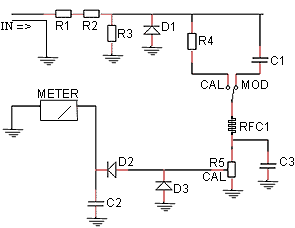
I think this is one of the most important test instruments you can have besides a watt meter, and an oscilloscope of course.
Of course we all know that they are pretty expensive so here is a circuit to build one. The parts are basic and inexpensive, the only hard part to get is the 2.5 millihenry choke. I haven't build this circuit, yet, so if you do let me know how it goes.

Circuit Description:
Assume for a moment that only the steady carrier is present and the operator is not
speaking into the microphone. During this time, the instrument is set to its calibrate
position by SW1. As the steady carrier passes through diode D1 it is converted to DC,
travels through the RF choke and reached the meter. This provides a reference point for
measuring modulation percentage. The calibration control is rotated until the meter reads
exactly full scale.
After calibration, SW1 is turned to its Modulation position. Now when the operator speaks into the microphone, the carrier changes strength with modulation. This time, however, the signal must pass through capacitor C1. This blocks the steady carrier and permits only pulsation's which represent the audio signal to pass through to the meter. Audio is recovered from the carrier by diodes D2 and D3, and the meter now responds by kicking in step at the voice rate, showing modulation percentage.
As you can see, this circuit uses an internal dummy load that can only handle about 6W. If you plan on using this meter with more power than that you will need to improve the dummy load, using power resistors or possibly making a jack for an external dummy load/antenna.
Parts List:
| Part # | ------ | Value |
|---|---|---|
| R1,R2,R3 | 16 ohm, 2 W | |
| R4 | 5600 ohm, 1/2 W | |
| R5 | 50K carbon pot | |
| D1,D2,D3 | 1N60 Germanium | |
| C1 | 4 microfarad | |
| C2, C3 | .005 microfarad | |
| METER | 0-50 microamps | |
| RFC1 | 2.5 millihenry choke | |
| SW1 | SPDT switch |